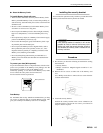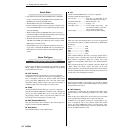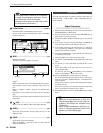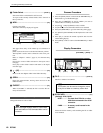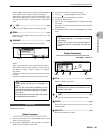
12. Saving to Memory Card or Disk
116 RS7000
About Disks
• Only DOS-format disks (The CD-ROM format is ISO9660
Level 1) can be used by the RS7000. Disks formatted by the
RS7000 are formatted using DOS format.
• The RS7000 cannot write to CD-R/RW disks.
• Disks formatted to DOS format by a personal computer can be
used with the RS7000, but we recommend using disks format-
ted by the RS7000.
• When formatted using the RS7000, disks with a capacity of
less than 260 MB are formatted using FAT16 format, and larger
disks are formatted using FAT32 format.
• MO disks which can be used with the RS7000 include 128 MB,
230 MB, and 540 MB types. MO disks with a capacity of 640
MB and above cannot be used.
• The RS7000 can use up to 2 GB removable disks. Even if a
larger disk is connected the RS7000 will use a maximum of 2
GB. Further, all removable disks are formatted using FAT16
format.
About File Types
The file styles handled via the SAVE page (Chapter 2: Pattern
Mode, Chapter 3: Pattern Chain Mode, Chapter 4: Song Mode)
are described in this section.
● PATT (Pattern)
All data included in the selected style is saved as a single file.
In addition to all 16 patterns in the style, corresponding to sec-
tions A through P, and all user phrases, PATT files include
groove, play effect, MIDI delay, mixer, voice edit, effect, setup,
and master settings. Further, when a style uses local samples or
common sample voices, the samples are saved as well.
● SONG
All data included in the selected song is saved as a single file.
Song files include the MIDI data recorded in tracks 1 through 16,
groove, play effect, MIDI delay, mixer, voice edit, effect, and
setup settings. Further, when a song uses local samples or com-
mon sample voices, the samples are saved as well.
● SMF (Standard MIDI File)
Only the performance data included in the selected pattern is
saved to a format-0 standard MIDI file.
● WAV (Wave)
The selected sample is saved in WAV format.
● ALL
All data in the RS7000 memory is saved as a single file.
ALL files include the following data:
All style data ......................... Style 01 ~ 64 (including 16 pat-
terns and 256 phrases per style).
All pattern chain data ............ Pattern chain 01 ~ 20
All song data.......................... Song 01 ~ 20
All sample voices .................. Local sample voices 001 ~ 128
and common sample voices 001 ~
128 for each style and song.
System setup ......................... Utility mode and other settings.
When any of the files described above are saved, an appropriate
3-character file extension is added automatically to differentiate
the file type.
PATT .................................. .R2P
SONG................................. .R2S
SMF ................................... .MID
WAV................................... .WAV
ALL.................................... .R2A
When a PATT, SONG or ALL file is saved, the sample data for
the sample voices is automatically saved with an R3P, R3S, or
R3A extension, respectively. When any of these file is then
loaded, the corresponding sample data is also loaded automati-
cally.
When organizing the files on a computer, place the “.R2P” and
“.R3P”, “.R2S” and “.R3S”, “.R2A” and “.R3A” in the same
folder, respectively. Also make sure that the names of the data file
and paired sample data file are the same in the first 8 characters of
the file names, not including the extension.
The file styles handled via the LOAD page (Chapter 2: Pattern
Mode, Chapter 3: Pattern Chain Mode, Chapter 4: Song Mode)
are described in this section.
● PATT (Pattern)
A single style is loaded into the specified style number in the
internal memory from a PATT type (.R2P) or ALL type (.R2A)
file.
When an ALL type (.R2A) file is selected, the style to be loaded
can be specified from multiple styles saved in the ALL file.
In addition to all 16 patterns in the style, corresponding to sec-
tions A through P, and all user phrases, PATT files include
groove, play effect, MIDI delay, mixer, voice edit, effect, setup,
and master settings. Further, when a style uses samples the sam-
ples are included in the file as well.
Files Types Handled In the Save Page
File Extensions
File Types Handled In the Load Page











